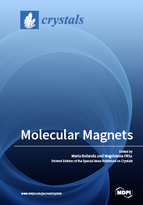Molecular Magnets
A special issue of Crystals (ISSN 2073-4352). This special issue belongs to the section "Organic Crystalline Materials".
Deadline for manuscript submissions: closed (30 November 2018) | Viewed by 36985
Special Issue Editors
Interests: magnetic and superconducting materials; phase transitions; magnetic relaxation; low-dimensional and functional molecular magnets
Interests: functional materials, molecular magnetism, molecular thin films, magnetocaloric effect
Special Issues, Collections and Topics in MDPI journals
Special Issue Information
Dear Colleagues,
Since the end of the 20th century, remarkable progress has been made in the study of the intriguing and diverse properties of magnetic molecular materials. As defined by Oliver Kahn, one of the founders of this area, “molecular magnetism deals with magnetic properties of isolated molecules and/or assemblies of molecules”. Basic research problems, as well as the potential functionality of the molecule-based systems in new technologies, present an important branch of modern science. At the first stage, research in the field of molecular magnetism was focused on intramolecular magnetic coupling in coordination complexes, the search for molecule-based long-range ordered magnets and the quest for magnetism in purely organic compounds. The discovery of magnetic bistability, quantum tunneling and slow relaxation in anisotropic high-spin molecules entered upon the era of molecular nanomagnets, which are the potential candidates for high-density magnetic storage, spintronics and quantum computing.
Research into molecular magnetism develops rapidly. This interdisciplinary field encompasses the rational design, chemical synthesis, experimental characterization and theoretical modeling of a molecular material showing acquired properties. The properties of the potentially-functional materials (magnetic ordering temperature, magnetic moment, coercive field, color, etc.) can be controlled by external stimuli, such as temperature, light, applied pressure or sorption of guest molecules. Molecular magnets showing spin crossover transitions, photomagnetism, optical activity or magnetic sponge behavior are good candidates for sensitive and selective sensors and switches. In the last few years, there has also been significant interest in the magnetocaloric effect in molecular materials, motivated by the possibility of applying this effect to magnetic refrigeration. The important direction in the field of molecular magnetism is formation of thin films of magnetic molecules or using molecular entities in hybrid nanoscale devices.
It is our pleasure to invite you to present the results of your work in this Special Issue devoted to molecular magnets. We hope to collect original papers as well as critical reviews and to gain a comprehensive report on the current work on this exciting and important topic.
Prof. Maria Bałanda
Dr. Magdalena Fitta
Guest Editors
Manuscript Submission Information
Manuscripts should be submitted online at www.mdpi.com by registering and logging in to this website. Once you are registered, click here to go to the submission form. Manuscripts can be submitted until the deadline. All submissions that pass pre-check are peer-reviewed. Accepted papers will be published continuously in the journal (as soon as accepted) and will be listed together on the special issue website. Research articles, review articles as well as short communications are invited. For planned papers, a title and short abstract (about 100 words) can be sent to the Editorial Office for announcement on this website.
Submitted manuscripts should not have been published previously, nor be under consideration for publication elsewhere (except conference proceedings papers). All manuscripts are thoroughly refereed through a single-blind peer-review process. A guide for authors and other relevant information for submission of manuscripts is available on the Instructions for Authors page. Crystals is an international peer-reviewed open access monthly journal published by MDPI.
Please visit the Instructions for Authors page before submitting a manuscript. The Article Processing Charge (APC) for publication in this open access journal is 2600 CHF (Swiss Francs). Submitted papers should be well formatted and use good English. Authors may use MDPI's English editing service prior to publication or during author revisions.
Keywords
- molecule-based magnets
- single-molecule magnets (SMM)
- single-chain magnets (SCM)
- spin crossover (SCO) compounds
- slow relaxation in molecular systems
- functionality in molecular magnetic materials
- molecular magnetic sponges and porous magnets
- magnetocaloric effect
- photomagnetism and optical activity
- thin layers of molecular magnets
- molecular spintronics






